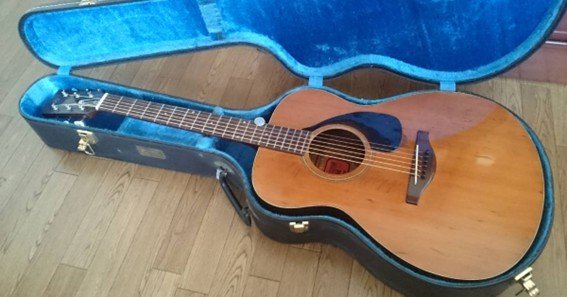The Yamaha FG-150, introduced in the late 1960s, holds a special place in the hearts of musicians and collectors alike. This folk guitar, affectionately known as the “Red Label” due to its distinctive internal label, has a rich history that intertwines with some of the most iconic moments in music.
A Brief History of the Yamaha FG-150
Produced between 1968 and 1973 by Nippon Gakki for Yamaha, the FG-150 was designed as an affordable yet quality option for both amateur and professional musicians. Its popularity soared during the 1969 Woodstock Festival, where an FG-150 backstage became the go-to instrument for artists warming up before performances. Notably, musician Country Joe used an FG-150 during his impromptu performance of the “I-Feel-Like-I’m-Fixin’-to-Die Rag,” a moment immortalized in the Woodstock film and soundtrack.
Design and Construction
The FG-150 features a design inspired by the Martin OM-14, characterized by its smaller, folk-friendly body shape. Key specifications include:
- Top: Solid spruce
- Back and Sides: Mahogany
- Neck: Mahogany
- Fretboard: Rosewood with simple dot inlays
- Body Dimensions:
- Width: 14 7/8 inches
- Depth: 4 1/8 inches
- Scale Length: 25 inches
- Nut Width: 1 23/32 inches
The guitar’s construction, particularly its solid spruce top combined with mahogany back and sides, contributes to its warm and resonant tonal qualities.
Sound Characteristics
Players often praise the FG-150 for its clear, punchy, and full voice, making it suitable for both light to medium flatpicking and fingerpicking styles. Despite its laminate construction, many musicians find that it delivers a tone comparable to solid wood guitars, especially when played in ensemble settings.
Market Value and Collectibility
The FG-150’s value varies based on condition and market demand. While some view it as an entry-level instrument, its historical significance and tonal qualities have made it a sought-after model among collectors. Prices can range from a few hundred to several thousand dollars, depending on factors such as age, condition, and originality.
Maintenance Considerations
Potential buyers should be aware that older FG-150s may require maintenance, such as neck resets, due to their age and construction methods. It’s advisable to consult with a luthier experienced with vintage Yamaha guitars before making a purchase.
FAQ
1. What does the “Red Label” signify in Yamaha FG-150 guitars?
The “Red Label” refers to the distinctive red label inside the soundhole, indicating that the guitar was manufactured in Yamaha’s Nippon Gakki factory in Japan between 1968 and 1973.
2. Are all FG-150 guitars made with laminate wood?
Yes, the FG-150 features laminate construction, which contributes to its durability and unique tonal characteristics.
3. How does the FG-150 compare to modern Yamaha acoustic guitars?
While modern Yamaha guitars offer advancements in materials and construction, the FG-150 remains cherished for its vintage tone and historical significance.
4. What should I look for when purchasing a vintage FG-150?
Inspect for structural integrity, neck alignment, and originality of components. Due to potential neck set issues, consulting with a knowledgeable luthier is recommended.
5. Can the FG-150 be used for professional recordings and performances?
Absolutely. Many musicians appreciate the FG-150’s rich tone and have used it in both studio recordings and live performances.
In conclusion, the Yamaha FG-150 stands as a testament to quality craftsmanship and timeless design. Its enduring appeal continues to inspire musicians across generations.
Read on to know more about hi-fi-rush-sales










